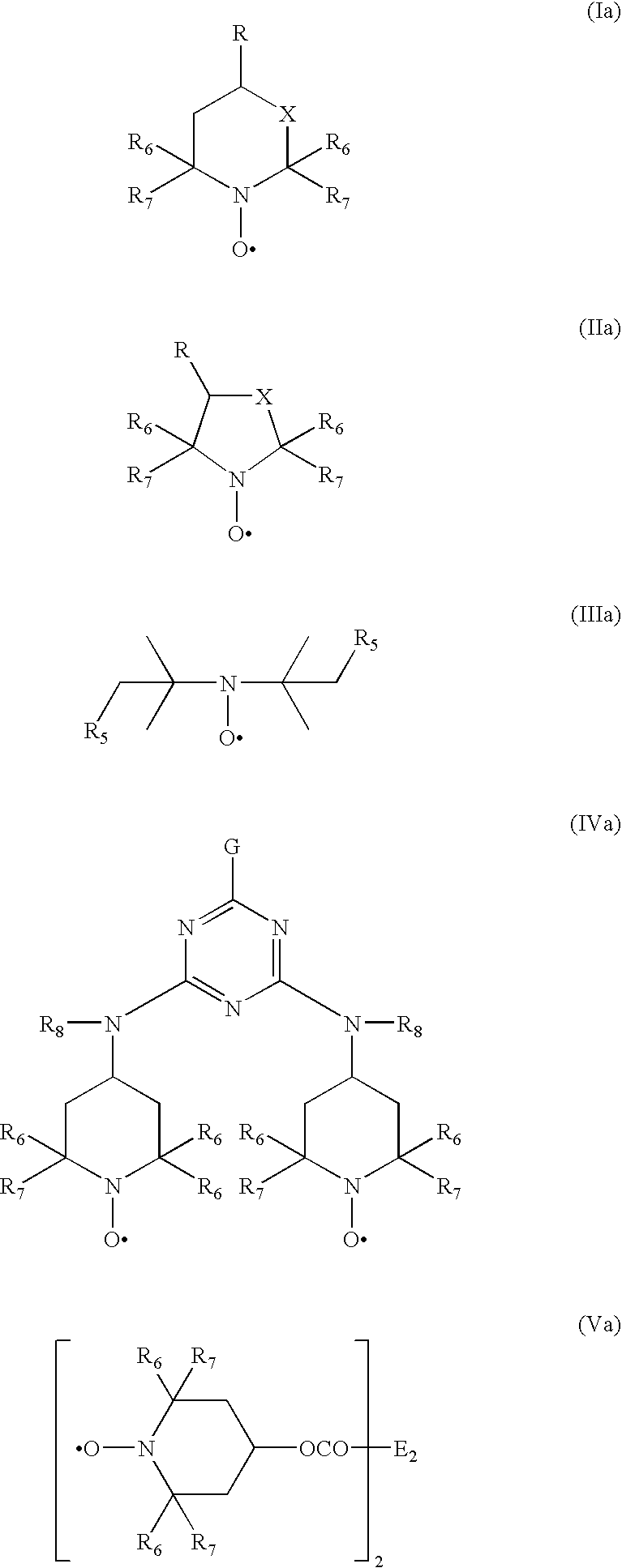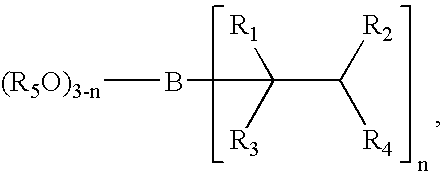Transition-metal-catalyzed process for the conversion of alkenes to sterically hindered substituted n-alkoxyamines
a technology of transition metal and catalyst, which is applied in the direction of physical/chemical process catalyst, organic compound/hydride/coordination complex catalyst, organic chemistry, etc., can solve the problem of inability to produce primary alkoxyamine derviatives
- Summary
- Abstract
- Description
- Claims
- Application Information
AI Technical Summary
Benefits of technology
Problems solved by technology
Method used
Image
Examples
example 1
Compound 49: 1-Ethoxy-4-hydroxy-2,2,6,6-tetramethylpiperidine
(1 mole Triethylborane / 1.5 mole Silver Nitrate / 3 mole Sodium Hydroxide)
[0226]
[0227]Into a suspension of 2.15 g (12.5 mmol) of 4-hydroxy-2,2,6,6-tetramethyl-piperidine-1-oxyl, 1.50 g (37.5 mmol) of sodium hydroxide and 3.17 g (18.8 mmol) of silver nitrate in 30 mL of water at ambient temperature under nitrogen is added dropwise 12.5 mL (12.5 mmol) a 1M tetrahydrofuran solution of triethylborane. During addition, the temperature of the reaction mixture increases from 23° C. to 40° C. After addition, the reddish color of the reaction mixture becomes colorless. Thin layer chromatography (50% ethyl acetate / heptane) shows no starting material. The reaction mixture is then extracted with total of 40 mL of ethyl acetate and dried over anhydrous sodium sulfate. Filtration is used to remove inorganic solids and the filtrate is concentrated to a crude off-white oil. The crude product is purified by dry-column flash chromatography (20...
example 2
Compound 49: 1-Ethoxy-4-hydroxy-2,2,6,6-tetramethylpiperidine
(0.3 mole Triethylborane / 1.5 mole Silver Nitrate / 3 mole Sodium Hydroxide)
[0229]
[0230]The procedure of Example (1) is repeated using 2.15 g (12.5 mmol) of 4-hydroxy-2,2,6,6-tetramethyl-piperidine-1-oxyl, 1.50 g (37.5 mmol) of sodium hydroxide, 3.17 g (18.8 mmol) of silver nitrate and 4.2 mL (4.2 mmol) a 1M tetrahydrofuran solution of triethylborane in 30 mL of water at ambient temperature. The aforementioned work up gives 2.20 g of crude off-white solid in 87.6% yield.
example 3
Compound 49: 1-Ethoxy-4-hydroxy-2,2,6,6-tetramethylpiperidine
(1 mole Triethylborane / 5% mole Silver Nitrate / 5% mole Copper(II) Acetate / 3 mole Sodium Hydroxide / Static Oxygen)
[0231]Into a suspension of 2.15 g (12.5 mmol) of 4hydroxy-2,2,6,6-tetramethyl-piperidine-1-oxyl, 1.50 g (37.5 mmol) of sodium hydroxide, 110 mg (0.625 mmol) of silver nitrate and 120 mg (0.625 mmol) of copper (II) acetate monohydrate in 40 mL of water at ambient temperature and a static blanket of atmospheric oxygen is added dropwise 12.5 mL (12.5 mmol) a 1M tetrahydrofuran solution of triethylborane After stirring for 48 hours, no starting nitroxyl is detected by thin layer chromatography. The reaction mixture is then extracted with total of 40 mL of ethyl acetate and dried over anhydrous sodium sulfate. Filtration is used to remove inorganic and filtrate is concentrated to a crude off-white oil. The product is purified by dry-column flash chromatography (20:80 / ethyl acetate:heptane eluent) to give 2.47 g of a wh...
PUM
| Property | Measurement | Unit |
|---|---|---|
| temperature | aaaaa | aaaaa |
| reaction temperature | aaaaa | aaaaa |
| reaction temperature | aaaaa | aaaaa |
Abstract
Description
Claims
Application Information
 Login to View More
Login to View More - R&D
- Intellectual Property
- Life Sciences
- Materials
- Tech Scout
- Unparalleled Data Quality
- Higher Quality Content
- 60% Fewer Hallucinations
Browse by: Latest US Patents, China's latest patents, Technical Efficacy Thesaurus, Application Domain, Technology Topic, Popular Technical Reports.
© 2025 PatSnap. All rights reserved.Legal|Privacy policy|Modern Slavery Act Transparency Statement|Sitemap|About US| Contact US: help@patsnap.com



